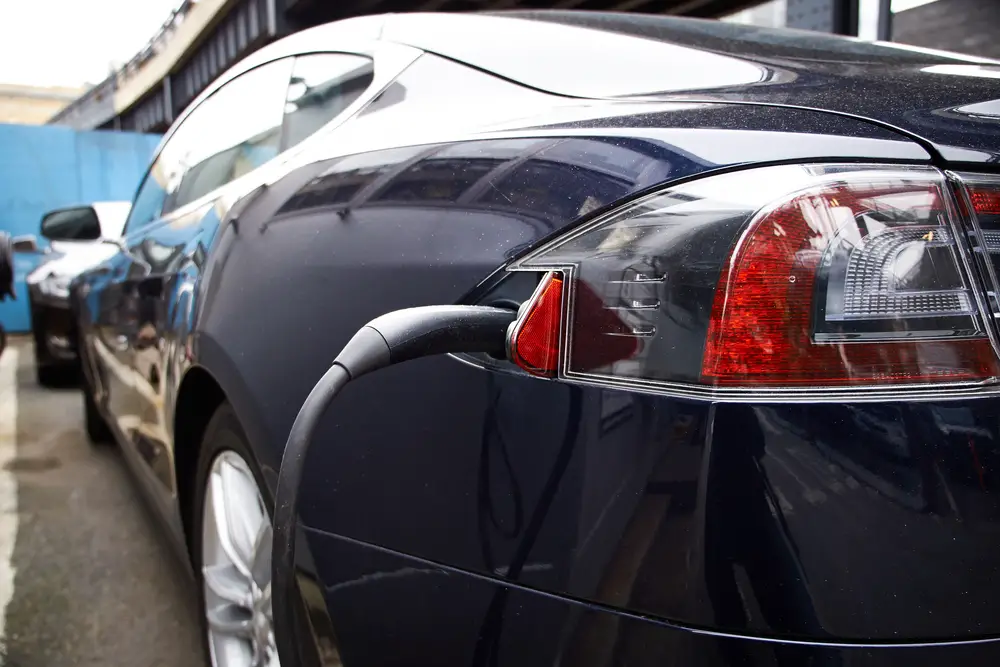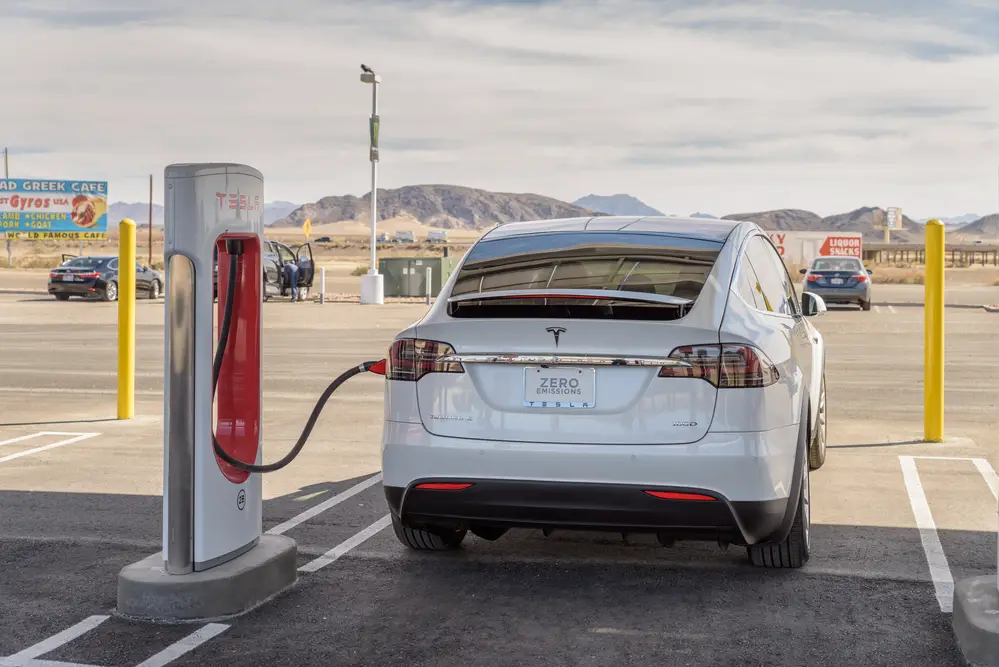As an electric vehicle (EV) owner, understanding how to manage charging is essential for both the health of your Tesla’s battery and ensuring a hassle-free experience.
One common question that arises is whether it is safe to leave a Tesla plugged in for an extended period.
Quick Answer:
Yes, you can leave your Tesla plugged in for a week. In fact, Tesla recommends leaving the vehicle plugged in when not in use. This is to maintain the battery pack’s temperature and keep the battery healthy, particularly in extreme weather conditions. The built-in charging system stops the charge when the battery is full, so there’s no risk of overcharging.
Following best practices for charging your Tesla can maximize the battery’s longevity and ensure your EV is ready to go when you need it.
Effects On Tesla Battery
Battery Drain
When you leave your Tesla plugged in for a week, the main lithium-ion battery will maintain its charge thanks to the sophisticated battery system. However, the smaller 12V battery that powers various systems in the car might experience a slight drain over an extended period of inactivity.
Tesla safeguards help prevent excessive discharge by cutting off non-essential systems when the 12V battery reaches a certain level.
Longevity and Health
According to Tesla, continually keeping your vehicle plugged in can extend the lifetime of the battery. The optimal charge percentage for maintaining battery health is between 50% and 90%. Tesla’s battery management system regulates the charging process to avoid overcharging, which could degrade the battery over time.
Lithium-ion batteries, like the ones used in Teslas, have a natural degradation process due to chemical reactions occurring within the battery. However, the impact of this process on your vehicle’s battery life is minimal, especially when taking advantage of Tesla’s recommended charging practices.
Charging Considerations
When leaving your Tesla plugged in for a week, there are several factors to consider.
Charge Limits
It is essential to set an appropriate charge limit to protect the battery’s long-term health. Tesla recommends setting a daily charge limit of around 80-90% for daily use, avoiding 100% charge unless needed for long trips.
Keeping the charge level within this range will help preserve the battery’s longevity and also keep it prepared for any unexpected power outages.
Charging Range
Battery range is directly related to the charge level in your Tesla. The more charged your vehicle is, the further it can travel on a single charge. If you plan on leaving your vehicle plugged in for an extended period, consider how far you’ll be driving when you next need the vehicle and set an appropriate charge limit accordingly.
Battery Charging Range
Tesla’s wall chargers can adjust the charging speed depending on factors such as battery temperature and the amount of available power. When leaving your car plugged in for a week, it is crucial to monitor the charging process, ensuring your vehicle reaches the desired charge level but does not exceed it.
Tesla vehicles have intelligent charging systems, which will prevent overcharging, but it may be wise to check the charge level periodically.
Weather and Extreme Elements
External factors like temperature and weather conditions can affect the charging process of your Tesla. For instance, colder temperatures can reduce the charging speed as the battery needs to be warmed up first.
Conversely, extremely hot temperatures can also impact the battery’s performance and charging ability. Make sure your Tesla is parked at a safe location with protection against harsh weather elements when leaving it plugged in for an extended period.
Tesla Features While Plugged In
While your Tesla is plugged in for an extended period, it continues to provide various useful features for you. These features include Sentry Mode, Cabin Overheat Protection, and Tesla App Notifications, which are explained in further detail below.
Sentry Mode
Sentry Mode is a security feature designed to protect your Tesla from potential threats while parked, whether inside or outside your garage. When enabled, this feature uses the vehicle’s external cameras to monitor its surroundings and detect suspicious activities.
In case of a potential threat, it will activate an alarm, and a notification will be sent to your Tesla App. Leaving your Tesla plugged in with Sentry Mode enabled ensures that your vehicle remains protected while you’re out of town.
Cabin Overheat Protection
Cabin Overheat Protection is another valuable feature offered by Tesla that ensures the well-being of your passengers and pets left inside the car. This feature monitors the internal temperature of your vehicle and activates the air conditioning system when necessary to maintain a safe temperature.
By leaving your Tesla plugged in, the Cabin Overheat Protection has access to the power needed to operate, providing that extra layer of safety and peace of mind.
Tesla App Notifications
The Tesla App is an essential tool for every Tesla owner that allows you to conveniently monitor and control various aspects of your vehicle.
While your Tesla is plugged in, the app will provide you with real-time notifications on your car’s charging status, security alerts from Sentry Mode, and updates on Cabin Overheat Protection. This enables you to stay informed and react promptly to any situation concerning your vehicle, even when you’re out of town.
Preventing Overcharging
Tesla Safeguards
Tesla has implemented various safeguards to ensure that its vehicles’ batteries remain protected from overcharging. These measures include intelligent charging systems that monitor the battery’s state of charge and adjust the charging process accordingly.
For instance, when your Tesla is plugged in for an extended period, such as a week, the battery management system automatically decreases the charge rate as the battery fills up. This mechanism helps avoid overcharging and prolongs the lifespan of the battery.
Charge Cycles
The manual recommends setting a charging limit to prevent constant charging, which can affect the battery’s health. It’s crucial to understand the concept of charge cycles for this purpose. A charge cycle occurs when your battery discharges from 100% to 0% and charges back to 100%.
In general, it’s ideal to maintain a charge limit of around 90% for daily usage, as it keeps the battery in good health without sacrificing too much range. Charging up to 100% is typically reserved for longer trips where you need the maximum range.
If you plan to leave your Tesla plugged in for a week, setting the charge limit to 90% will help ensure that the battery doesn’t become overcharged.
| Charging Limit | Usage Scenario |
|---|---|
| 50% – 60% | Long-term storage |
| 80% – 90% | Daily driving |
| 100% | Long-distance trips |
Temporary Storage and Disuse
Disconnecting for Vacations
If you’re planning a vacation or leaving your Tesla unplugged for a week, there’s no need to worry. Tesla’s lithium-ion battery is designed to manage its energy consumption efficiently when the vehicle is not in use.
As a friendly reminder, it is recommended to keep your vehicle plugged in to maintain the optimum battery temperature, especially during extreme hot or cold weather. However, leaving it unplugged for a short period is unlikely to cause any significant issues.
Here are a few steps to consider before leaving your Tesla for an extended break:
- Set the charging limit to 50-80% to balance both battery health and range
- Activate “Energy Saving” mode to conserve battery power
- Enable “Cabin Overheat Protection” if you expect high temperatures while you’re away
Long-Term Out-of-Use Behavior
If you plan on leaving your Tesla in storage or out of use for an extended period, there are some crucial factors to consider. Long-term disuse can potentially affect the lithium-ion battery, causing a reduction in its overall efficiency.
To mitigate potential risks, follow these suggestions:
- Charge the battery to approximately 50% before storing
- Check the battery status at least once a month, and recharge as necessary
- Keep the vehicle covered to protect it from environmental factors such as UV light
Overall, Tesla vehicles are designed to handle temporary storage and disuse efficiently.
Preparing For a Trip
Car Maintenance Tips
Before embarking on a week-long trip, it’s essential to ensure your Tesla is in top-notch condition. Regular maintenance will help prevent any unexpected issues while you’re away.
Here are some general tips for Tesla models, including Model S, Model 3, and Model X:
- Check tire pressure and adjust if necessary to ensure optimal range and efficiency.
- Inspect wiper blades and fluid levels, especially if you anticipate rainy weather.
- Clean the charging port and inspect it for any damage.
- Examine the Tesla battery for signs of wear or swelling, as extreme temperatures can affect its performance.
Climate Control
Electric cars like Teslas depend on the battery for both heating and cooling. When leaving your Tesla plugged in for a week, it’s wise to take advantage of the vehicle’s climate control system:
- Use the mobile app to schedule climate control, ensuring a comfortable interior temperature while parked.
- In extreme temperatures, Tesla’s Battery Management System (BMS) will automatically cool or heat the battery to maintain optimal performance.
Charger Compatibility
When leaving your Tesla plugged in for an extended period, ensure that the charging connection and outlet are compatible. Tesla recommends using a 240-volt NEMA 14-50 outlet for home charging.
This outlet type provides a consistent and efficient electric car charging experience. However, here are some additional factors to consider:
- Ensure the charging cable is in good condition and compatible with your Tesla model.
- Double-check the charging settings in your vehicle, adjusting the charging limit to prevent overcharging.
- If you are away from home and using a different charger, verify compatibility with your Model S, Model 3, or Model X. Keep in mind some charging stations may require an adapter.
Environmental Considerations
Emissions
When it comes to emissions, leaving your Tesla plugged in for a week has some environmental benefits.
Unlike gasoline-powered vehicles, which emit carbon monoxide and other harmful pollutants, electric vehicles (EVs) like Teslas produce zero tailpipe emissions. This means that while your Tesla is plugged in and charging, it is not contributing to air pollution.
It’s also essential to consider the source of the electricity used to charge your Tesla. If the electricity comes from renewable energy sources such as solar or wind, the environmental impact is significantly reduced compared to using electricity generated from fossil fuels.
Minimizing Battery Degradation
Another environmental consideration is the health of your Tesla’s battery. Prolonged periods of inactivity can cause vampire battery drain, which is when the battery slowly loses charge while the car is not in use.
To minimize battery degradation and maintain optimal efficiency, it’s important to properly manage your Tesla’s charging habits. Plugging in your Tesla for a week can help in this regard.
- Charge regularly: Try to maintain a consistent charging schedule, ideally every few days, to keep the battery in an optimal state.
- Monitor: Keep an eye on your Tesla’s battery level through the companion app, and ensure it does not fall below 20% or consistently stay above 80%. Both extremes can contribute to battery degradation.



